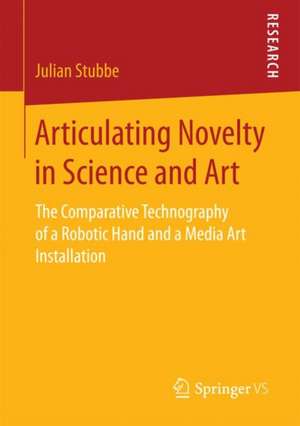Articulating Novelty in Science and Art: The Comparative Technography of a Robotic Hand and a Media Art Installation
Autor Julian Stubbeen Limba Engleză Paperback – 25 iul 2017
Preț: 446.84 lei
Nou
Puncte Express: 670
Preț estimativ în valută:
85.58€ • 88.17$ • 71.69£
85.58€ • 88.17$ • 71.69£
Carte tipărită la comandă
Livrare economică 24 februarie-10 martie
Preluare comenzi: 021 569.72.76
Specificații
ISBN-13: 9783658189785
ISBN-10: 3658189789
Pagini: 245
Ilustrații: XII, 245 p. 30 illus.
Dimensiuni: 148 x 210 mm
Greutate: 0.31 kg
Ediția:1st ed. 2017
Editura: Springer Fachmedien Wiesbaden
Colecția Springer VS
Locul publicării:Wiesbaden, Germany
ISBN-10: 3658189789
Pagini: 245
Ilustrații: XII, 245 p. 30 illus.
Dimensiuni: 148 x 210 mm
Greutate: 0.31 kg
Ediția:1st ed. 2017
Editura: Springer Fachmedien Wiesbaden
Colecția Springer VS
Locul publicării:Wiesbaden, Germany
Cuprins
Novelty and technological objects.- Three articulations of novelty: identity, form, and difference.- The aesthetic reflexivity of material practice.
Notă biografică
Dr. Julian Stubbe currently works as scientific consultant in the field of demographic change and future research.
Textul de pe ultima copertă
Julian Stubbe aims at characterizing what novelty is in the becoming of objects and how the new becomes part of a shared reality. The study’s method is comparative and concerned with technological practice in science as well as in art. It draws on a detailed comparison of two cases: the becoming of a robotic hand made from silicon, and the genesis of a media art installation that renders visible changes in the earth’s magnetic field. In contrast to the canon of sociological innovation studies, which regard novelty as what actors in the field label as new or innovation, the author attempts to delineate certain shifts in an object’s becoming that individuate an object and render its difference visible. This entails attending the enactment of novelty through cultural imaginaries and narratives about technologies, as well as acknowledging the shifts in technical forms that make loose elements enter a new kind of circularity. From this perspective, novelty is an articulation: when differences are not contradicting, but when differing characteristics are aligned, fitted, and click in so as to appear and behave as a distinct entity.
Contents
• Novelty and technological objects
• Three articulations of novelty: identity, form, and difference
• The aesthetic reflexivity of material practice
Target Groups
• Lecturers and students of sociology, especially of sociology of technology
The Author
Dr. Julian Stubbe currently works as scientific consultant in the field of demographic change and future research.
Caracteristici
A comparative study linking science and art Includes supplementary material: sn.pub/extras
